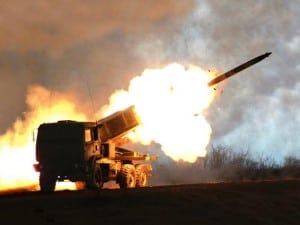The Army plans to seek congressional approval to award multi-year procurement contracts for GMLRS rockets and Patriot Advanced Capability (PAC)-3 missiles in fiscal year 2024, officials confirmed this week.
Army Secretary Christine Wormuth and Doug Bush, the service’s top acquisition official, both cited cost savings and industrial base stability as key factors associated with pursuing multi-year deals for the two Lockheed Martin
[LMT]-built munitions.

Photo: Lockheed Martin
“We are looking in FY ‘24 to work with Congress to be able to get multi-year procurement authority for things like PAC-3 missiles, for example, and GMLRS. So you know we’ve got some work to do there before that comes to fruition but we’re going to work hard on that with Congress. And, again, I think that is a win-win for us in the Army as well as those of you in industry,” Wormuth told attendees at the McAleese Conference in Washington, D.C.
While Congress included a provision allowing multi-year deals for certain critical munitions in the latest defense policy bill, Army officials have noted the service will require specific approval language from the appropriations committees to enter into such deals above $500 million.
The Pentagon’s $842 billion FY ‘24 budget request included the department’s plans to pursue multi-year contracts for several Air and Navy programs, to include Kongsberg’s Naval Strike Missile, Raytheon Technologies’ [RTX] RIM-174 Standard Missile (SM-6) and Advanced Medium Range Air-to-Air Missile, Lockheed Martin’s Long Range Anti-Ship Missile and Joint Air-to-Surface Standoff Missile – Extended Range (Defense Daily, March 13).
Bush told reporters on Wednesday the lack of specifics during Monday’s budget briefings on what the Army would pursue with multi-year deals was due to “minor administrative snags.”
“I’ve already been asked by the committees for information about our potential multi-years. So, at the end of the day, like I said, members will decide anyways. But we’re working with [the Office of Management and Budget] and it’ll be fine and it’s on track. Ultimately, though, Congress decides. I think we have the numbers to justify [it], but they’ll make that call,” Bush said following his own remarks at the McAleese Conference.
Bush added multi-year contracts are “very hard to pilfer,” reiterating previous comments on the benefits for providing guaranteed funding streams to industry.
“Once you’ve got a multi-year contract in place, breaking that up is a huge bar to get over inside the Pentagon and on the Hill. My experience with our multi-years is once you’re in a multi-year, that money’s basically locked away,” Bush said. “Multi-years are one flavor of trying to buy in bulk. That’s the most locked-in version where you’re really hard-committing to several years. And you often with multi-years get the best price discount because that’s almost guaranteed funding over many years.”
Both GMLRS, which are fired out of Lockheed Martin’s HIMARS launchers, and PAC-3 missiles, used with the Patriot air defense system, have “maxed-out” production capacity, according to Bush.
“GMLRS and PAC-3, those production lines when you add in Foreign Military Sales are absolutely maxed out over the times that we’re looking at. A maxed out production situation is perfect for a multi-year because the quantities are sufficient to get the economies of scale to get a better price,” Bush said.
For deals below the $500 million threshold, Wormuth said the Army is already “starting to initiate multi-year contracts in [FY] ‘23 for artillery rounds and artillery charges.”
Wormuth noted the Army’s previous use of large multi-year procurement deals for platforms such as helicopters.
“It has generated stability for industry and it has also brought cost savings to us in the Army. Needless to say, I am a fan of multi-year procurement authorities,” Wormuth said.